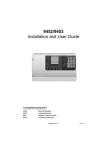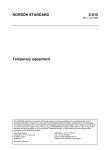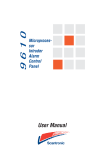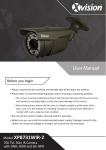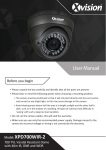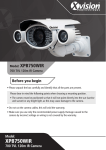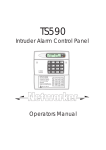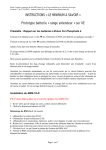Download 9600 inside.p65
Transcript
9600/9610 Installation and User Guide COMPATIBLE EQUIPMENT 9624 9625 9626 9050 9040 9056 9076-01/02 9066 9685 947 951 Plug-on 4-Zone Expansion Card (max. 2) 9600 Remote Keypad (max. 4) 9610 Remote Keypad (max. 4) Flush mounting kit for keypads Internal loudspeaker Plug-on Digital Communicator Relay Interface Self-Contained Bell (SCB Module) Plug on Red Care S.T.U. (manufactured by others) Serial Printer Serial Printer with standby battery Serial lead for 947 printer 496333 Issue 1 1 of 20 9600/9610 Introduction The 9600 and 9610 control panels are designed for both domestic and medium sized comercial installations. The control units provide connections for eight zones on the main pcb, and can be expanded up to 16 zones by adding two 9624 plug-on expander cards. The control unit pcbs are fitted in blank steel cases, and connect to up to four remote keypads. Both systems can accept plug-on communicators, and provide four open collector outputs (bell and strobe plus two programmable). There is an additional programmable relay output on each 9624 expansion card (outputs 3 and 4). The main differences between the 9600 and 9610 are: 9600 9610 Uses the 9625 keypad. Uses the 9626 (backlit keys and status LED). 128 event log. 250 event log. Fire zone and double knock. Not included. Not included. Coded remote reset, entry stray abort. Technical Specification Operating temperature Humidity Dimensions (main panel) Weight (Control Panel) Stand-by Battery -10° C to + 40° C. Up to 80% non-condensing. h x w x d 330 x 350 x 76mm. 4.85 Kg (Excl. battery). 12 Volt, 6AH rechargeable battery. Power Supply System output current System output current Main Control Panel pcb Each Remote Keypad Standard 9066 SCB Module Plug-on 9056 Communicator 1250mA (Ambient Temp. 20° C). 800mA (Ambient Temp. 40° C max.). 45mA quiescent. 45mA quiescent. 50mA quiescent. 30mA quiescent. Outputs OP 1 and 2 OP 3 and 4 500mA continuous, 1A surge. Relay contacts rated at 2A, 24V DC. Keypad Wiring Recommended maximum distances for the remote keypads from the control panel, using standard alarm cable is 100 metres for the star configuration, 300 m for the daisy chain configuration using four keypads. 2 of 20 496333 Issue 1 9600/9610 Addressing Keypads Before programming the Control unit, the engineer must program an identification number into the NVM chip on each remote keypad in the system. This is achieved as follows: 1. Set the PROG switch on each keypad to ON and the TEST switch to OFF. 2. Ensure that the bells and strobe are disconnected and that there is no auxiliary power connected to detectors. 3. Close the control panel lid, power up the control panel, mains supply first. The keypad display shows the software V1:00 14/07/88 version numer of the keypad: 4. 5. 6. Note the software version number. Press NO. The displays shows the current keypad address, for example: 1:01 Change the keypad address (if it is not correct already) by entering a 2digit number between 01 and 04. The displays shows the new address, for example: 1:02 Note: If the system has more than one keypad on that address the system will malfunction 7. 8. 9. Press NO. The display shows the status of the keypad sounder, 0 for ON or 1 for OFF (normally left at 0), for example: 2:0 Change the status of the sounder by pressing 1 or 0. The display shows the selected status, for example: 2:1 Press NO. The displays shows the current status of the keypad back light, 0 for timed of 1 for always on, for example: 3:0 10. Change the backlight status as required by pressing 1 or 0. The display shows the selected status, for example: 3:1 11. Press NO. The display shows the current status of the keypad keys, 0 for keys Active, 1 for keys Non-Active (normally left at 0), for example: 4:0 12. Change the keypad status as required by pressing 1 or 0. The display shows the selected status, for example: 496333 Issue 1 4:1 3 of 20 Keypad Display Tests (Optional) 9600/9610 13. Repeat steps 4 to 12 for all the other keypads. 14. Set the PROG switch on each keypad to OFF and power down the control panel to lock the keypad+s program into the their NVMs. Keypad Display Tests (Optional) 15. Set the TEST switch on each keypad to ON and carry out the following display tests for each keypad a) Power up the control panel. The display shows all 32 characters as solid black. b) Press NO. The display clears and shows a cursor (line) at the top left hand character. c) Press all the number keys in turn, followed by No, Yes, A, B, C and D. The display will show all number keys as the appropriate number, the No key as ‘A’. Yes key as ‘B’, the ‘A’ key as ‘C’, the ‘B’ key as ‘D’, the ‘C’ key as ‘E’ and the ‘D’ key as ‘F’, for example: 123456789ABCDEF d) Repeat the keypad test for all system keypads. 16. Power down the control panel and set the TEST switches on all keypads to OFF. 17. Refit all keypads onto their backplates, ensuring that their tamper switches are closed. 18. Carry out the Initial Start Up procedure. 4 of 20 496333 Issue 1 9600/9610 Wiring Figure 1. 9600 Control Panel Wiring 496333 Issue 1 5 of 20 Wiring 9600/9610 Figure 2. 9610 Control Panel Wiring 6 of 20 496333 Issue 1 9600/9610 Wiring Figure 3. 9625 Keypad Wiring Figure 4. 9626 Keypad Wiring 496333 Issue 1 7 of 20 Programming 9600/9610 Figure 5. Four-Zone expansion Board Wiring Programming Initial Start Up Having programmed all the keypads in the system, power up the control panel, battery first, then mains. Close the control panel lid and proceed as follows: The keypad display shows: 00:00 MON 01 JAN 1. Key in 1234 (the default User Code). The display shows: SYSTEM UNSET followed by : 00:00 MON 01 JAN (the displays may vary depending on system status) 2. Key in 07890 (the default engineer code). The display shows: RESET SYSTEM? YES/NO 3. Press NO. The display shows: PROGRAM SYSTEM? YES/NO 4. Press Yes. Note: If after pressing ‘Yes’ to ‘PROGRAM SYSTEM’ you want to cancel this option, press the ‘No’ key. This will also cancel the Keypad Sounder 5. 6. 7. The keypad sounder gives a continuous tone, and the display shows: OPEN END STATION Open the control panel lid. If you are using an engineer keypad then plug it in at this point. Press Yes twice. The display shows: PROGRAM ZONES? YES/NO Connect all auxiliary power connections for detectors and SAB. Carry on to select one of the engineer functions (see “Engineer Program Commands”). 8 of 20 496333 Issue 1 9600/9610 Defaults Defaults FUNCTION User code authority User code 1 User codes 2 to 7 Engineer code Zone used Zone description Group, zone Group, enable Chime 24 hour monitoring Double Knock Omit Allowed Zone on test Exit mode Exit time Entry time Alarm type Instant bells O/P 1 Output type O/P 2 Output type O/P 3 Output type O/P 4 Output type Bell type Bell duration Bell delay Day tamper comms System full reset PA reset (9600 only) Remote CSID (9610 only) Abort facility Line fault Remote reset Auto re-arm Continuous sounder Delayed Entry Alarm Logging Printer DESCRIPTION AND DEFAULTS Master manager (user code 1) 1234 Not programmed 0 7890 Not used Zone 1 to 16 None Not used Disabled Disabled Disabled (9600 only) Disabled Disabled Timed 10 seconds 10 seconds A=Full, B, C and D Local Instant Set Latch Shock sensor reset Entry/Exit follow (9610 = Bell Follow) Bell follow SAB 20 minutes None Disabled Customer Customer Disabled Disabled Audible Disabled Once (9610 Always) Disabled Disabled Disabled 496333 Issue 1 9 of 20 Programming Commands 9600/9610 Engineer Program Commands While programming the system, the control unit shows a series of questions on the keypad display. Answer the questions by pressing Yes or No on the keypad. When you respond to a question the control unit will display further questions in order to lead you through the programming sequence. In the first stages of programming the system there are a set of numbered entry points that let you go directly to a specific area of programming. These numbers are shown in the following table: Command Keypad display 1 Program zones? 2 Program Groups? 3 Program Outputs? 4 Program Bells? 5 Engineer Code? 6 Miscellaneous? 7 Load Defaults? (CSID Code? on 9610) 8 Load Defaults? (9610 only) 9 Reset System? 0 Walk Test? The next four pages show the programming commands in more detail. 10 of 20 496333 Issue 1 9600/9610 Programming Chart 496333 Issue 1 11 of 20 Programming Chart 12 of 20 9600/9610 496333 Issue 1 9600/9610 Programming Chart 496333 Issue 1 13 of 20 Programming Chart 9600/9610 Entering Text The 9629 Engineering Programming Template is designed for use when programming the ‘free-format’ zone descriptions. Fit the template over the keypad keys and proceed as follows: 14 of 20 496333 Issue 1 9600/9610 Entering Engineer Mode from Day Mode Note: Press one of the four left hand keys before entering every letter, number or space. If you make a mistake you can correct the entry by pressing the <- key to delete characters . You can change existing descriptions to another descripton by pressing the ‘No’ key to delete and then re-entering new description. Entering Engineer Mode from Day Mode 1. Key-in 0 then engineer code (for example: 7890) The display shows: RESET SYSTEM? YES/NO See -Initial Start Up+. Enginer Reset 1. 2. Key-in 0 then engineer code (for example: 7890) The display shows: RESET SYSTEM? YES/NO Press Yes. 496333 Issue 1 15 of 20 Refreshing the NVM 9600/9610 REFRESHING THE NVM (9600) If the user and/or engineer codes are lost, or you wish to revert to the standard factory default codes: 1. Remove all power - both mains and battery. 2. Remove the NVM chip IC8 (above the large microcontroller chip). 3. Power up the panel - battery first then mains. 4. Refit the NVM chip. The panel will now load the standard factory default codes. 5. Re-program the panel with all the installation settings. Refreshing the NVM (9610) 1. 2. 3. 4. Remove all power - both mains and battery. Place a small screwdriver between the two pins marked CON1 located above the large microcontroller chip. With the screwdriver shorting the pins, power the panel - battery first then mains. The panel will now load the standard factory default codes. Re-program the panel with all the installation settings. Error Messages CANNOT RESET System is unable to reset due to fault existing, check as necessary. EXIT FAULT User has exceeded the programmed exit time or a fault exists with the detection on exit route, check as necessary. FIRE (9600 only) A smoke or heat detector fitted to the system has been activated. INVALID CODE Incorrect user code has been entered, re-try up to 4 times before tamper alarm will occur. MAINS FAILED 240V main supply to control panel lost, check fuse board or spur outlet. PERSONAL ATTACK A personal attack button fitted to the system has been activated. PRINTER FAULT The logging printer has been disconnected, deselected or has ran out of paper. 16 of 20 496333 Issue 1 9600/9610 Error Messages SYSTEM FAULT Fault within control panel. SYSTEM RESET System has successfully reset, all wiring and circuits are correct. TAMPER FAULT System anti-tamper switch opened or damage to wiring has occurred. 24 HOUR ALARM A zone programmed as 24 hour alarm has been violated, display will show description. Check system as necessary. AUX POWER FAIL The load on the AUX 12V supply is excessive and the protecting polyswitch fuse has been operated. BATTERY FAIL The battery has become faulty and will not maintain the system in the event of a power failure. COMMS FAILED The system has tried to contact the central station but for some reason has failed. COMMS LINE FAULT Log message corresponding to the TELEPHONE FAILED message on the display. COMMS SUCCESSFUL The central station has successfully acknowledged receipt of a communication. KEYPAD NN TAMPER Either the wiring to keypad nn has been cut or the keypad tamper switch has been opened. LOW BATTERY The battery voltage is at a seriously low level. Mains power must be restored to the system in the near future otherwise the system will fail completely. SYSTEM INHIBITED If there are two or more keypads fitted to the system, all keypads except the one in use will display SYSTEM INHIBITED during engineering. TELEPHONE FAILED The telephone line has become disconnected or faulty. If possible check the connection to the panel. UNIT TAMPER Check the external sounder wiring. If an SAB is not fitted check that TR and 0V are linked. Also check loudspeaker tamper (A/T connections) are closed circuit . 496333 Issue 1 17 of 20 User Commands 9600/9610 WATCHDOG FAULT A mains transient or severe electrostatic discharge has upset the system software. The system has restarted itself and should be functioning normally. ZONE TEST FAILED One or more zones are on 14 day test (soak test),. Some of these zones have been violated during the set period and would have caused an alarm. The panel will continue to operate correctly. KEYPAD 00 TAMPER Mains power-up has occurred. Power down control panel (mains and battery), then re-apply power (battery first, then mains) to clear this fault. User Commands The end users operate the 9600 and 9610 systems by pressing Yes or No on the keypads in response to a series of questions that the system presents in the display. Access to the systems’ functions is split into three authority levels : Manager, Operator, and Block Omit. The default access code “1234” has Manager authority. The system allows a total of seven codes, and any code can be assigned to any authority level. User authority allows access to: a) Arming, disarming and resetting the system (if not programmed for Engineer reset). b) Omitting zones (if zones are Omit Allowed). c) Setting Chime on or off. d) Viewing the event log. e) Carrying out all test functions. Manager authority also allows access to the following additional functions: f) Omitting and re-instating 24 hour zones (if zones are Omit Allowed). g) Setting system time and date. h) Changing user code authority. i) Changing and deleting user codes. j) Printing the log. The Block Omit code has very limited authority. The code has no access to any functions defined for User or Manager. The code does allow a user (for example a cleaner) to arm or disarm any area defined as Group D, but only while one of the other three groups is armed. 18 of 20 496333 Issue 1 9600/9610 Invalid Access Code Entered Invalid access code entered If you enter an invalid access code then the display shows: INVALID ACCESS CODE? YES/NO Press the ‘Yes’ or ‘No’ key and re-enter valid access code number. Emphasise this point to customers when training them on the system. 496333 Issue 1 19 of 20 20 of 20 496333 Issue 1




















